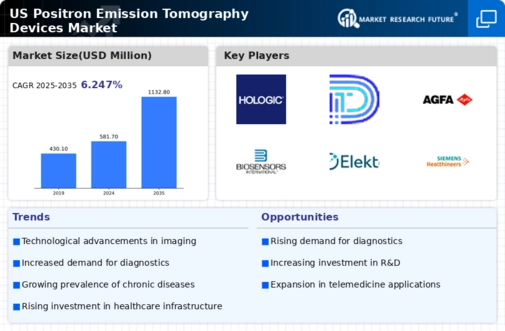The US Positron Emission Tomography Devices Market is characterized by rapid advancements and a competitive landscape that is constantly evolving. Numerous players are vying for market share, each aiming to innovate and provide state-of-the-art solutions for diagnostic imaging. This market features a combination of established firms and newer entrants, all of whom are investing in research and development to enhance image quality, reduce radiation exposure, and improve patient comfort. The increasing demand for early disease detection and the growing prevalence of cancer and cardiovascular diseases have spurred companies to focus on introducing technology that can provide more accurate outcomes.
Furthermore, strategic partnerships, mergers, and acquisitions are prevalent as firms seek to bolster their market positions through synergy, enhanced product offerings, and expanded distribution channels.
Hologic has established a significant presence in the US Positron Emission Tomography Devices Market, leveraging its strong brand and industry expertise. The company is well-known for its pioneering efforts in diagnostic imaging systems, particularly in the fields of breast health and gynecological diagnostics. Hologic's strengths lie in its commitment to innovation and quality, which enables it to deliver advanced PET solutions that meet the needs of healthcare providers and patients alike. With a robust portfolio of products, Hologic has successfully integrated advanced imaging technologies with a focus on improving patient outcomes, allowing it to stand out within this competitive sector.
Their strategic approach, including strong research collaboration and active investments in technology, further enhances their position in the market.
Dilon Technologies plays a significant role in the US Positron Emission Tomography Devices Market, particularly noted for its innovative contributions to molecular imaging. The company's primary focus is on providing high-quality gamma cameras that are pivotal in the early detection of cancer. Dilon's strength lies in its ability to develop compact and highly efficient PET technology, which is specifically designed for breast imaging and other diagnostic applications. The company has gained a competitive edge through strategic mergers and acquisitions that have expanded its technological capabilities and product range, allowing for enhanced diagnostic services.
By maintaining a strong market presence, Dilon Technologies is committed to providing advanced imaging solutions that contribute to improved patient management and treatment options. Overall, its dedication to innovation and quality underpins its impact within the US market, strengthening its capabilities and partnerships in this dynamic healthcare landscape.






















